Induction of Biosynthesis Antioxidant Molecules in Young Barley Plants by Trioxygen
Abstract
1. Introduction
2. Results and Discussion
2.1. Antioxidant Activity, Total Phenolic Content and Ascorbic Acid Content
2.2. Determination of Polyphenolic Compounds
2.3. Antioxidant Enzymes Activity
2.4. Enzymatic Antioxidants
3. Materials and Methods
3.1. Plant Materials
3.2. The Ozone Treatment of the Plant Material
3.3. Determination of Antioxidant Activity
3.4. Total Phenolic Content Assay
3.5. Total Ascorbic Assay
3.6. Polyphenolic Compounds Analysis
3.6.1. Sample Preparation
3.6.2. Determination of Polyphenols Profile
3.7. SOD, CAT, GPOX, PPO and PAL Activity
3.8. ROS Level Analysis
3.9. Statistical Analysis
4. Conclusions
Author Contributions
Funding
Institutional Review Board Statement
Informed Consent Statement
Data Availability Statement
Conflicts of Interest
References
- Yiannakopoulou, E.C. Effect of green tea catechins on breast carcinogenesis: A systematic review of in-vitro and in-vivo experimental studies. Eur. J. Cancer Prev. 2014, 3, 84–89. [Google Scholar] [CrossRef] [PubMed]
- Cutler, G.J.; Nettleton, J.A.; Ross, J.A.; Harnack, L.J.; Jacobs, D.R., Jr. Dietary flavonoid intake and risk of cancer in postmenopausal women: The Iowa Women’s Health Study. Int. J. Cancer 2008, 123, 664–671. [Google Scholar] [CrossRef] [PubMed]
- Neuhouser, M.L. Dietary flavonoids and cancer risk: Evidence from human population studies. Nutr. Cancer 2004, 50, 1–7. [Google Scholar] [CrossRef]
- Sun, M.; Nie, S.; Pan, X.; Zhang, R.; Fan, Z.; Wang, S. Quercetin-nanostructured lipid carriers: Characteristics and anti-breast cancer activities in vitro. Col. Surf. B 2014, 113, 15–24. [Google Scholar] [CrossRef]
- Purushothaman, A.; Nandhakumar, E.; Sachdanandam, P. Phytochemical analysis and anticancer capacity of Shemamruthaa, a herbal formulation against DMBA-induced mammary carcinoma in rats. Asian Pac. J. Trop. Med. 2013, 6, 925–933. [Google Scholar] [CrossRef]
- PaulíčkoVá, I.; EhrENbErgEroVá, J.; FIEdlEroVá, V.; Gabrovska, D.; Havlova, P.; Holasova, M.; Kopáček, J.; Ouhrabková, J.; Pinkrová, J.; Rysová, J. Evaluation of barley grass as a potential source of some nutritional substances. Czech J. Food Sci. 2007, 25, 65. [Google Scholar] [CrossRef]
- Ferreres, F.; Andrade, P.B.; Valentao, P.; Gil-Izquierdo, A. Further knowledge on barley (Hordeum vulgare L.) leaves O-glycosyl-C-glycosyl flavones by liquid chromatography-UV diode-array detection-electrospray ionisation mass spectrometry. J. Chromatogr. A 2008, 1182, 56–64. [Google Scholar] [CrossRef]
- Kamiyama, M.; Shibamoto, T. Flavonoids with potent antioxidant activity found in young green barley leaves. J. Agric. Food Chem. 2012, 60, 6260–6267. [Google Scholar] [CrossRef]
- Zeng, X.; Pu, X.; Yang, J.; Du, J.; Yang, X.; Li, X.; Li, L.; Zhou, Y.; Yang, T. Preventive and Therapeutic Role of Functional Ingredients of Barley Grass for Chronic Diseases in Human Beings. Hindawi Oxidative Med. Cell. Longev. 2018, 2018, 3232080. [Google Scholar] [CrossRef]
- Benedet, J.A.; Umeda, H.; Shibamoto, T. Antioxidant activity of flavonoids isolated from young green barley leaves toward biological lipid samples. J. Agric. Food Chem. 2007, 55, 5499–5504. [Google Scholar] [CrossRef]
- Brezinová Belcredi, N.; Ehrenbergerová, J.; Fiedlerová, V.; Bĕláková, S.; Vaculová, K. Antioxidant vitamins in barley green biomass. J. Agric. Food Chem. 2010, 58, 11755–11761. [Google Scholar] [CrossRef] [PubMed]
- Ehrenbergerová, J.; Brezinová Belcredi, N.; Kopácek, J.; Melisová, L.; Hrstková, P.; Macuchová, S.; Vaculov, K.; Paulícková, I. Antioxidant enzymes in barley green biomass. Plant Foods Hum. Nutr. 2009, 64, 122–128. [Google Scholar] [CrossRef] [PubMed]
- Balić, A.; Mokos, M. Do We Utilize Our Knowledge of the Skin Protective Effects of Carotenoids Enough? Antioxidants 2019, 8, 259. [Google Scholar] [CrossRef] [PubMed]
- Matłok, N.; Stępień, A.E.; Gorzelany, J.; Wojnarowska-Nowak, R.; Balawejder, M. Effects of Organic and Mineral Fertilization on Yield and Selected Quality Parameters for Dried Herbs of Two Varieties of Oregano (Origanum vulgare L.). Appl. Sci. 2020, 10, 5503. [Google Scholar] [CrossRef]
- Matłok, N.; Gorzelany, J.; Stępień, A.E.; Figiel, A.; Balawejder, M. Effect of Fertilization in Selected Phytometric Features and Contents of Bioactive Compounds in Dry Matter of Two Varieties of Basil (Ocimum basilicum L.). Sustainability 2019, 11, 6590. [Google Scholar] [CrossRef]
- Marti, G.; Schnee, S.; Andrey, Y.; Simoes-Pires, C.; Carrupt, P.-A.; Wolfender, J.-L.; Gindro, K. Study of Leaf Metabolome Modifications Induced by UV-C Radiations in Representative Vitis, Cissus and Cannabis Species by LC-MS Based Metabolomics and Antioxidant Assays. Molecules 2014, 19, 14004–14021. [Google Scholar] [CrossRef] [PubMed]
- Zhong, Z.; Wang, X.; Yin, X.; Tian, J.; Komatsu, S. Morphophysiological and Proteomic Responses on Plants of Irradiation with Electromagnetic Waves. Int. J. Mol. Sci. 2021, 22, 12239. [Google Scholar] [CrossRef]
- Zapałowska, A.; Matłok, N.; Zardzewiały, M.; Piechowiak, T.; Balawejder, M. Effect of Ozone Treatment on the Quality of Sea Buckthorn (Hippophae rhamnoides L.). Plants 2021, 10, 847. [Google Scholar] [CrossRef]
- Matłok, N.; Kapusta, I.; Piechowiak, T.; Zardzewiały, M.; Gorzelany, J.; Balawejder, M. Characterisation of Some Phytochemicals Extracted from Black Elder (Sambucus nigra L.) Flowers Subjected to Ozone Treatment. Molecules 2021, 26, 5548. [Google Scholar] [CrossRef]
- Zardzewiały, M.; Matlok, N.; Piechowiak, T.; Gorzelany, J.; Balawejder, M. Ozone Treatment as a Process of Quality Improvement Method of Rhubarb (Rheum rhaponticum L.) Petioles during Storage. Appl. Sci. 2020, 10, 8282. [Google Scholar] [CrossRef]
- Gorzelany, J.; Migut, D.; Matłok, N.; Antos, P.; Kuźniar, P.; Balawejder, M. Impact of Pre-Ozonation on Mechanical Properties of Selected Genotypes of Cucumber Fruits During the Souring Process. Ozone Sci. Eng. 2017, 39, 188–195. [Google Scholar] [CrossRef]
- Matlok, N.; Piechowiak, T.; Gorzelany, J.; Zardzewiały, M.; Balawejder, M. Effect of Ozone Fumigation on Physiological Processes and Bioactive Compounds of Red-Veined Sorrel (Rumex sanguineus ssp. sanguineus). Agronomy 2020, 10, 1726. [Google Scholar] [CrossRef]
- Rai, R.; Agrawal, M. Impact of Tropospheric Ozone on Crop Plants. Proc. Natl. Acad. Sci. India Sect. B Biol. Sci. 2012, 82, 241–257. [Google Scholar] [CrossRef]
- Xiao Gang, L.; Bin, J.; Jieting, L.; Qiujin, M.; Yakov, K.; Fengmin, L. Nitrogen fertilization decreases the decomposition of soil organic matter and plant residues in planted soils. Soil Biol. Biochem. 2017, 112, 47–55. [Google Scholar] [CrossRef]
- Matłok, N.; Piechowiak, T.; Zardzewiały, M.; Gorzelany, J.; Balawejder, M. Effects of Ozone Treatment on Microbial Status and the Contents of Selected Bioactive Compounds in Origanum majorana L. Plants. Plants 2020, 9, 1637. [Google Scholar] [CrossRef] [PubMed]
- Temple, P.J.; Taylor, O.C.; Benoit, L.F. Effects of ozone on yield of two field-grown barley cultivars. Environ. Pollut. Ser. A Ecol. Biol. 1985, 39, 217–225. [Google Scholar] [CrossRef]
- Gutiérrez, D.R.; Lemos, L.; Rodríguez, S.D.C. Effect of UV-C and Ozone on the Bioactive Compounds and Antioxidant Capacity of Minimally Processed Rocket (Eruca Sativa Mill.). IJNTR 2018, 4, 23–29. [Google Scholar] [CrossRef]
- Boonkorn, P.; Gemma, H.; Sugaya, S.; Setha, S.; Uthaibutra, J.; Whangchai, K. Impact of high-dose, short periods of ozone exposure on green mold and antioxidant enzyme activity of tangerine fruit. Postharvest Biol. Technol. 2012, 67, 25–28. [Google Scholar] [CrossRef]
- Matłok, N.; Piechowiak, T.; Zardzewiały, M.; Balawejder, M. Effect of Ozone Treatment on the Contents of Selected Bioactive Phytochemicals in Leaves of Alligator Plant Kalanchoe daigremontiana. Appl. Sci. 2022, 12, 8934. [Google Scholar] [CrossRef]
- Mellidou, I.; Koukounaras, A.; Kostas, S.; Patelou, E.; Kanellis, A.K. Regulation of Vitamin C Accumulation for Improved Tomato Fruit Quality and Alleviation of Abiotic Stress. Genes 2021, 12, 694. [Google Scholar] [CrossRef]
- Piechowiak, T.; Antos, P.; Kosowski, P.; Skrobacz, K.; Józefczyk, R.; Balawejder, M. Impact of ozonation process on the microbiological and antioxidant status of raspberry (Rubus ideaeus L.) fruit during storage at room temperature. Agric. Food Sci. 2019, 28, 35–44. [Google Scholar] [CrossRef]
- Abbas, M.; Saeed, F.; Anjum, F.M.; Afzaal, M.; Tufail, Y.; Bashir, M.D.; Ishtiaq, A.; Hussain, S.; Suleria, H.A.R. Natural polyphenols: An overview. Int. J. Food Prop. 2017, 20, 1689–1699. [Google Scholar] [CrossRef]
- Ferguson, L.R.; Zhu, S.; Harris, P.J. Antioxidant and antigenotoxic effects of plant cell wall hydroxycinnamic acids in cultured HT-29 cells. Mol. Nutr. Food Res. 2005, 49, 585–693. [Google Scholar] [CrossRef]
- Wang, J.; Xu, J.; Gong, X.; Yang, M.; Zhang, C.; Li, M. Biosynthesis, Chemistry, and Pharmacology of Polyphenols from Chinese Salvia Species: A Review. Molecules 2019, 24, 155. [Google Scholar] [CrossRef] [PubMed]
- Chen, J.; Hu, Y.; Wang, J.; Hu, H.; Cui, H. Combined Effect of Ozone Treatment and Modified Atmosphere Packaging on Antioxidant Defense System of Fresh-Cut Green Peppers. J. Food Process. Preserv. 2016, 40, 1145–1150. [Google Scholar] [CrossRef]
- Yoruk, R.; Marshall, M.R. Physicochemical properties and function of plant polyphenol oxidase: A review. J. Food Biochem. 2003, 27, 361–422. [Google Scholar] [CrossRef]
- Eissa, H.A.; Fadel, H.H.M.; Ibrahim, G.E.; Hassan, I.M.; Elrashid, A.A. Thiol Containing Compounds as Controlling Agents of Enzymatic Browning in Some Apple Products. Food Res. Int. 2006, 39, 855–863. [Google Scholar] [CrossRef]
- Patil, S.; Torres, B.; Tiwari, B.K.; Wijngaard, H.H.; Bourke, P.; Cullen, P.J.; O’ Donnell, C.P.; Valdramidis, V.P. Safety and Quality Assessment during the Ozonation of Cloudy Apple Juice. J. Food Sci. 2010, 75, M437–M443. [Google Scholar] [CrossRef]
- Flanagan, E. Ozone in Water Purification and Bromate Formation. Water Online, 19 April 2021. [Google Scholar]
- Gorny, J.R. A Summary of Ca and Ma Requirements and Recommendations for Fresh-Cut (Minimally Processed) Fruits and Vegetables. Acta Hortic. 2003, 600, 609–614. [Google Scholar] [CrossRef]
- Ragnar, M.; Eriksson, T.; Reitberger, T. Radical Formation in Ozone Reactions with Lignin and Carbohydrate Model Compounds. Holzforschung 1999, 53, 292–298. [Google Scholar] [CrossRef]
- Piechowiak, T.; Balawejder, M. Impact of ozonation process on the level of selected oxidative stress markers in raspberries stored at room temperature. Food Chem. 2019, 298, 125093. [Google Scholar] [CrossRef] [PubMed]
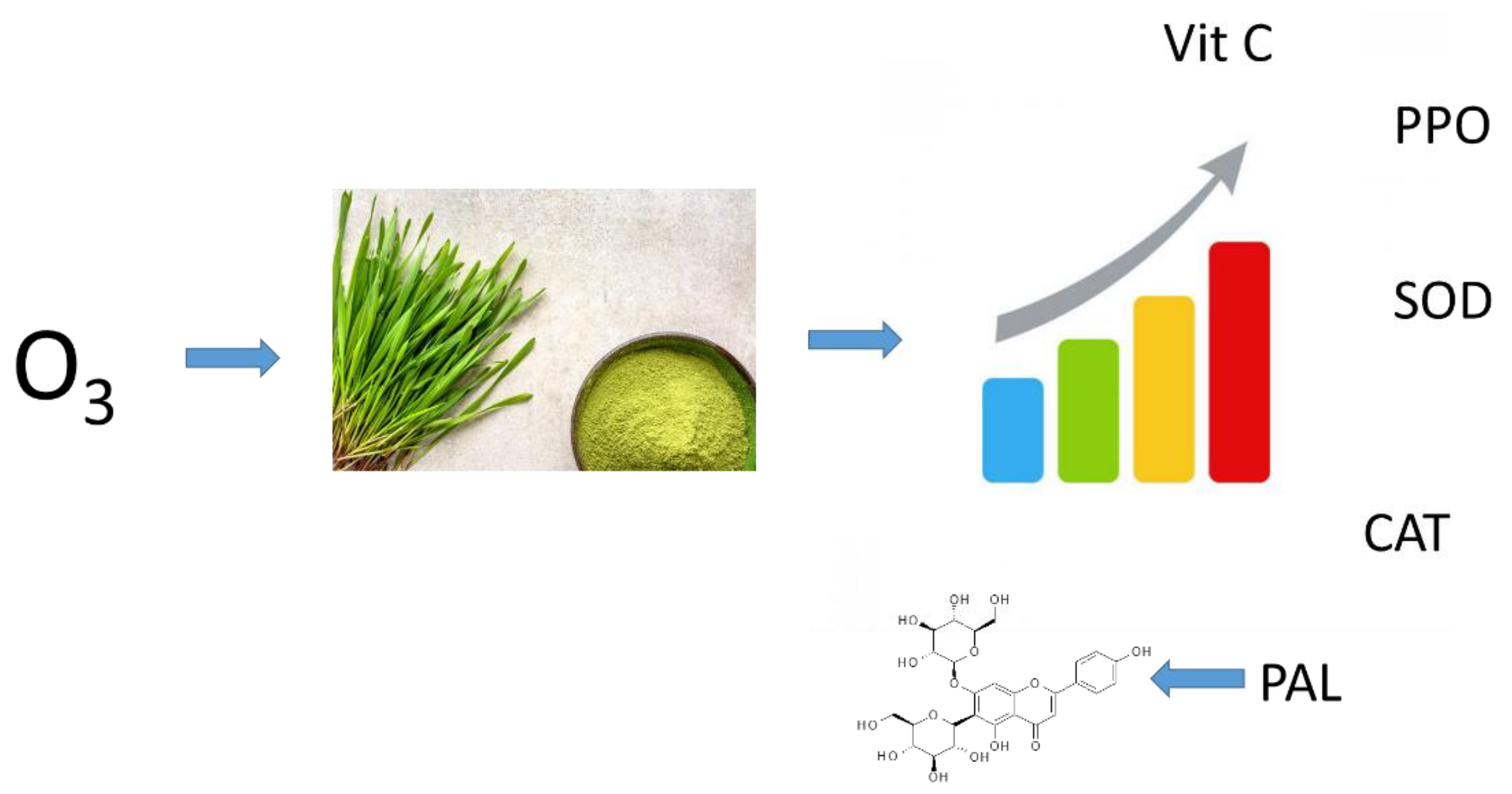

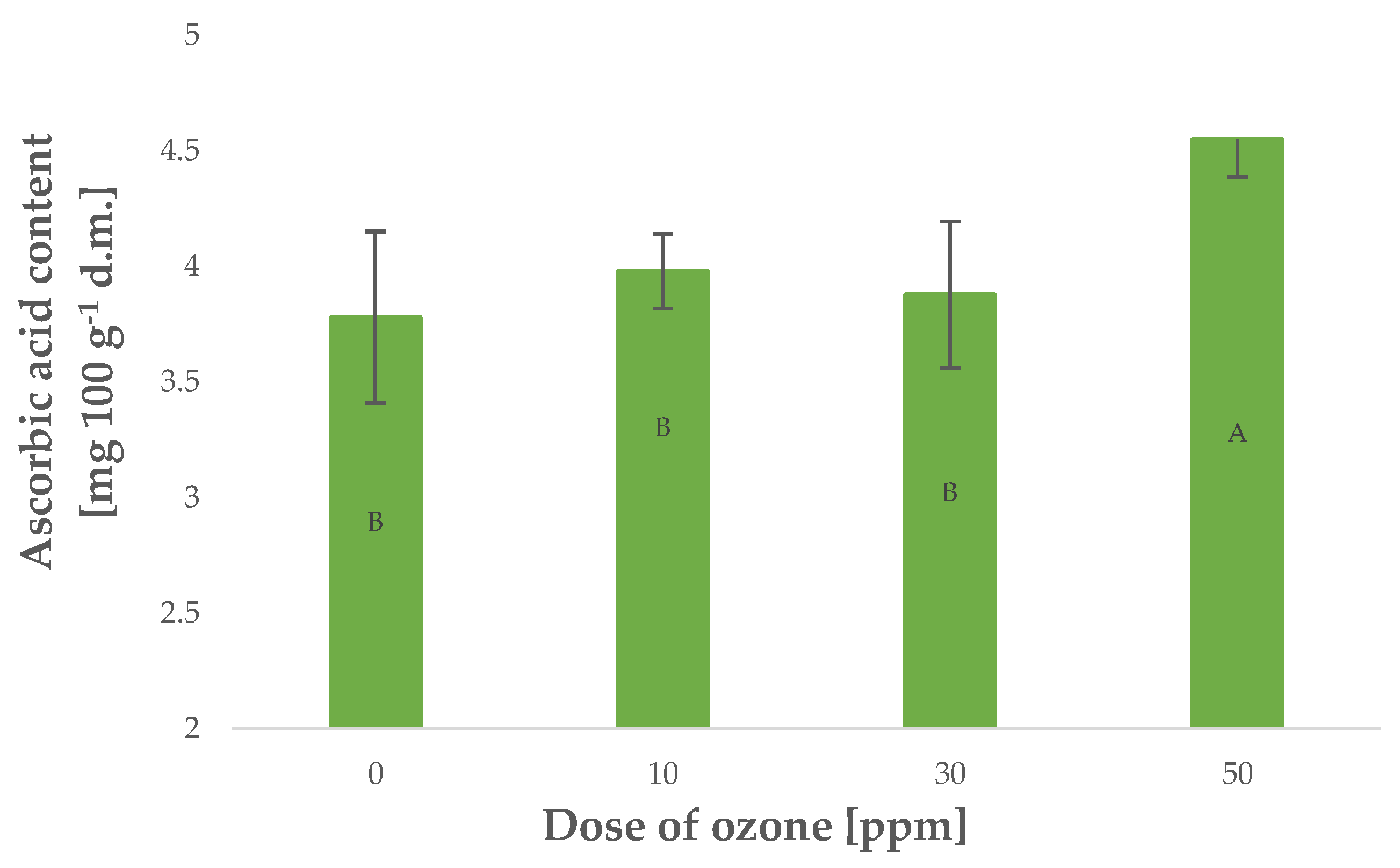

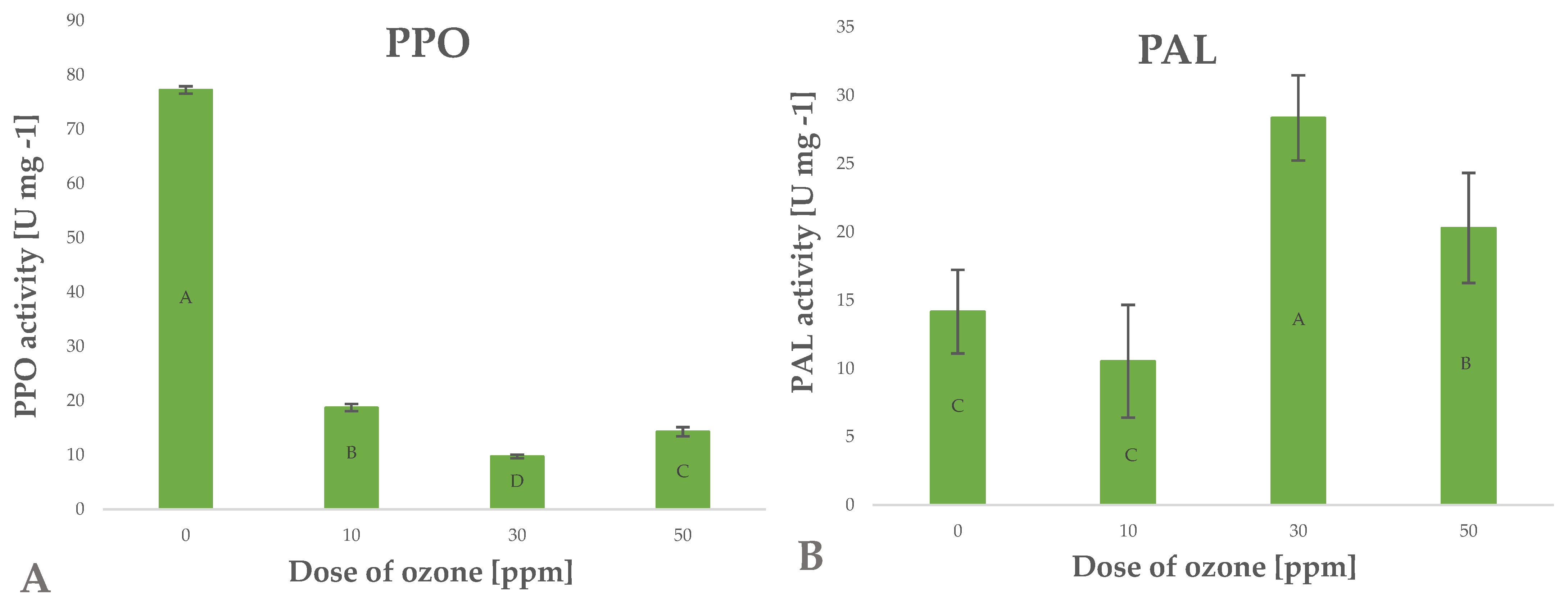
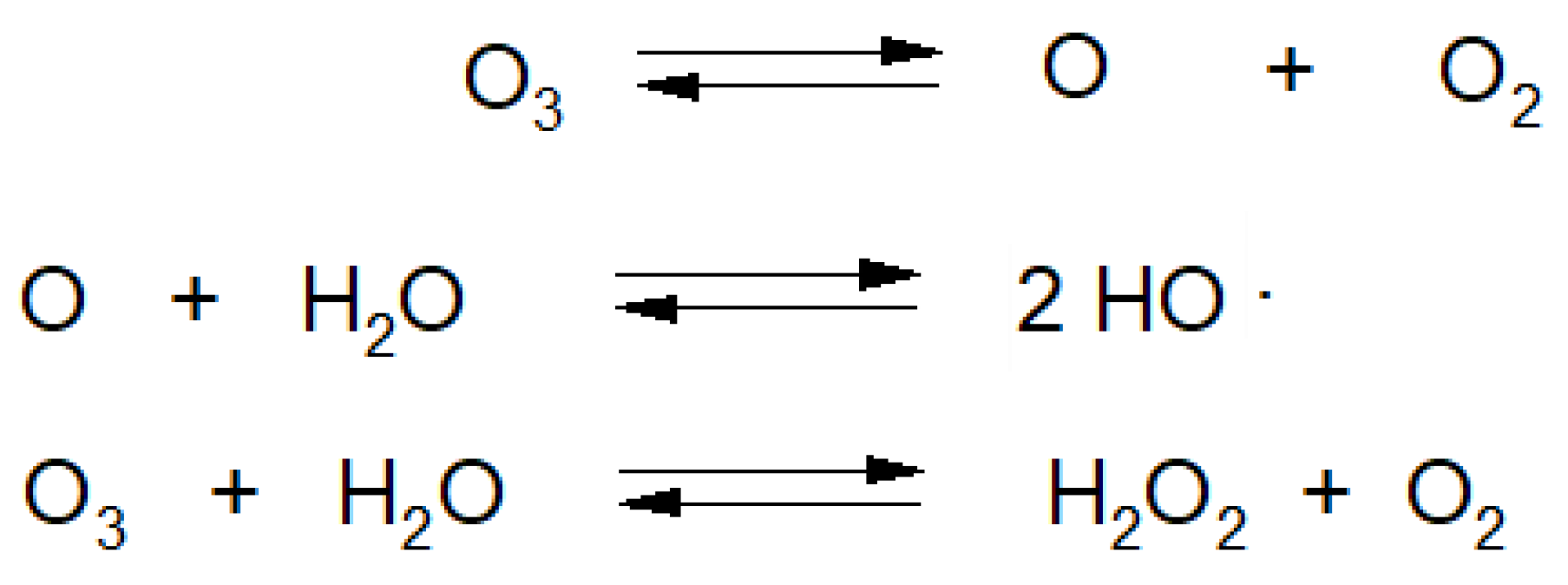

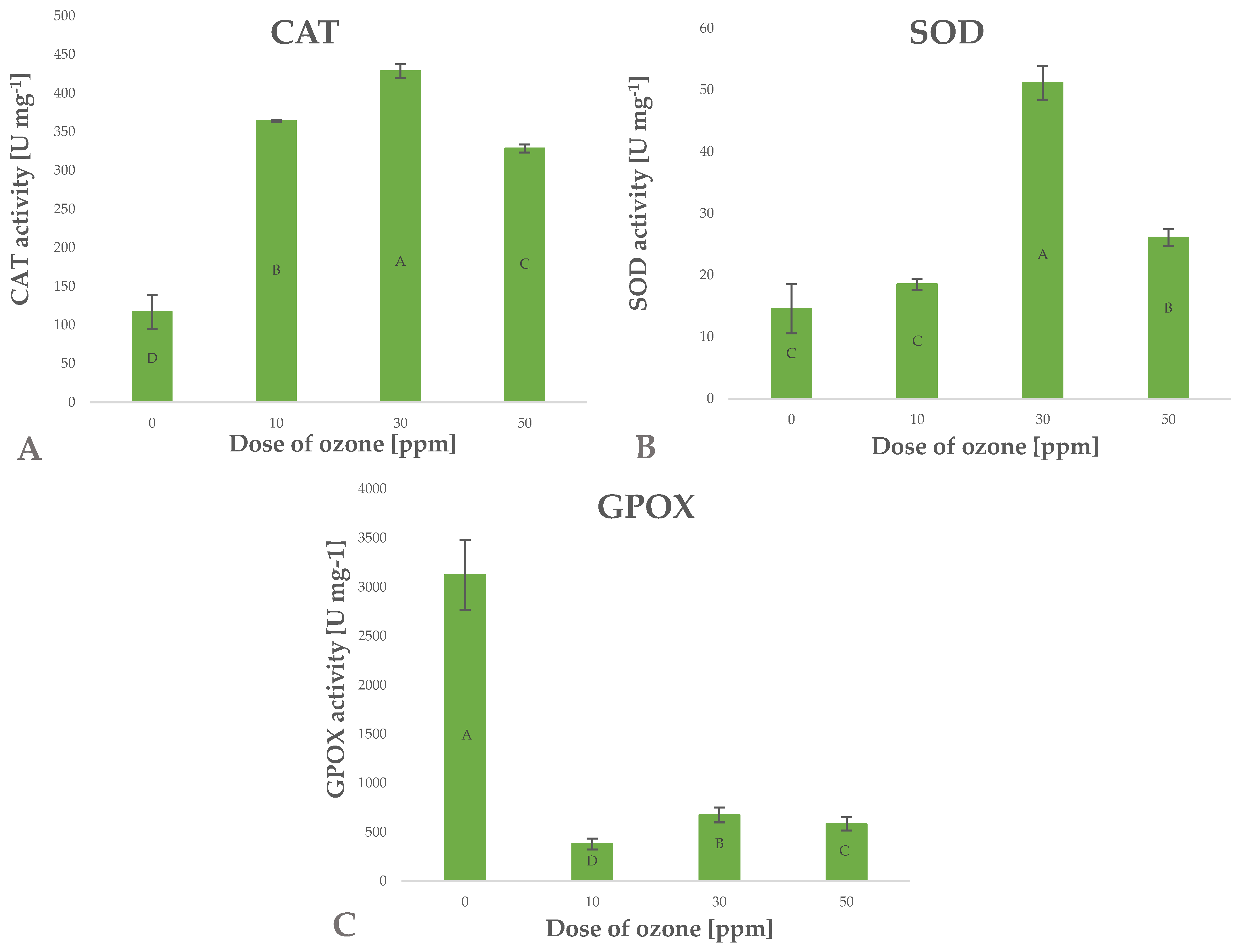
| Compound | RT * | λmax | [M-H] m/z | Content (%) | |||||
|---|---|---|---|---|---|---|---|---|---|
| min | nm | MS | MS/MS | 0 ppm 0 min | 10 ppm 10 min | 30 ppm 10 min | 50 ppm 10 min | ||
| 1 | p-coumaric acid | 2.73 | 309 | 163 | 119 | 0.06 | 0.30 | 0.34 | 0.25 |
| 2 | Caftaric acid | 2.96 | 288 sh. 327 | 311 | 179 | 0.15 | 0.19 | 0.30 | 0.17 |
| 3 | Feruloyl-caffeic acid | 3.15 | 288 sh. 322 | 367 | 193 | 0.12 | 0.14 | 0.21 | 0.09 |
| 4 | Unspecified caffeic derivative | 3.24 | 288 sh. 324 | 425 | 367 | 0.04 | 0.31 | 0.34 | 0.32 |
| 5 | Luteolin 6-C-arabinoside-8-C-glucoside | 3.38 | 274. 341 | 579 | 447. 285 | 1.25 | 0.92 | 0.90 | 0.91 |
| 6 | Isoscoparin 7-O-glucoside | 3.51 | 276. 333 | 623 | 461. 299 | 0.22 | 0.32 | 0.36 | 0.04 |
| 7 | Isoorientin 7-O-glucoside | 3.75 | 269. 347 | 609 | 447. 285 | 1.21 | 1.18 | 0.91 | 1.42 |
| 8 | Isovitexin 7-O-glucoside | 3.88 | 269. 331 | 593 | 431 | 81.72 | 79.42 | 82.06 | 82.31 |
| 9 | Isovitexin 7-O-(6″-p-coumaroyl)-glucoside | 3.98 | 271. 324 | 739 | 593 | 1.49 | 2.69 | 1.82 | 2.05 |
| 10 | Isovitexin | 4.18 | 270. 338 | 431 | 269 | 0.52 | 0.03 | 0.20 | 0.35 |
| 11 | Isoorientin 7-O-(6″-sinapoyl)-glucoside | 4.57 | 271. 338 | 815 | 447 | 0.43 | 0.25 | 0.37 | 0.22 |
| 12 | Isoorientin 7-O-(6″-feruloyl)-glucoside | 4.72 | 271. 338 | 785 | 447 | 0.40 | 0.05 | 0.09 | 0.12 |
| 13 | Isovitexin 7-O-(6″-sinapoyl)-glucoside | 5.00 | 271. 334 | 799 | 431 | 6.33 | 8.86 | 7.42 | 6.61 |
| 14 | Isovitexin 7-O-(6″-sinapoyl)-glucoside-4′-O-glucoside | 5.11 | 270. 338 | 961 | 799. 593 | 0.51 | 0.37 | 0.18 | 0.11 |
| 15 | Isovitexin 7-O-(6″-feruloyl)-glucoside | 5.21 | 271. 331 | 769 | 431 | 4.71 | 4.48 | 4.04 | 4.50 |
| 16 | Apigenin 6-C-arabinoside-8-C-glucoside | 5.35 | 269. 329 | 563 | 443 | 0.87 | 0.51 | 0.47 | 0.54 |
Publisher’s Note: MDPI stays neutral with regard to jurisdictional claims in published maps and institutional affiliations. |
© 2022 by the authors. Licensee MDPI, Basel, Switzerland. This article is an open access article distributed under the terms and conditions of the Creative Commons Attribution (CC BY) license (https://creativecommons.org/licenses/by/4.0/).
Share and Cite
Matłok, N.; Piechowiak, T.; Kapusta, I.; Królikowski, K.; Balawejder, M. Induction of Biosynthesis Antioxidant Molecules in Young Barley Plants by Trioxygen. Molecules 2022, 27, 7195. https://doi.org/10.3390/molecules27217195
Matłok N, Piechowiak T, Kapusta I, Królikowski K, Balawejder M. Induction of Biosynthesis Antioxidant Molecules in Young Barley Plants by Trioxygen. Molecules. 2022; 27(21):7195. https://doi.org/10.3390/molecules27217195
Chicago/Turabian StyleMatłok, Natalia, Tomasz Piechowiak, Ireneusz Kapusta, Kamil Królikowski, and Maciej Balawejder. 2022. "Induction of Biosynthesis Antioxidant Molecules in Young Barley Plants by Trioxygen" Molecules 27, no. 21: 7195. https://doi.org/10.3390/molecules27217195
APA StyleMatłok, N., Piechowiak, T., Kapusta, I., Królikowski, K., & Balawejder, M. (2022). Induction of Biosynthesis Antioxidant Molecules in Young Barley Plants by Trioxygen. Molecules, 27(21), 7195. https://doi.org/10.3390/molecules27217195









